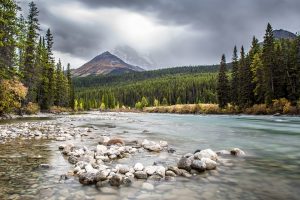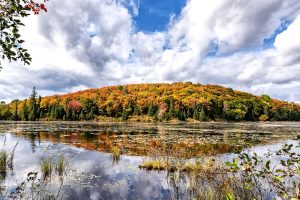Introduction: Enigmatic Giants of the North
Nestled in the remote reaches of the Arctic Circle lies a landscape of mysterious beauty known as Tuktoyaktuk, or Tuk as it is affectionately called by locals. This small hamlet in Canada’s Northwest Territories is home to a collection of remarkable natural formations: the Tuktoyaktuk Pingos. Resembling icy sentinels guarding the horizon, these hills are not only a geological wonder but also an integral part of the region’s allure. With their lush green crowns in summer and snow-cloaked slopes in winter, they invite travelers to witness the splendor of the High Arctic’s unique topography.
It is not just the dramatic visage of the pingos that captures the imagination but also the sheer isolation of their location. Getting there is a journey into the wild, pristine wilderness of the tundra. This is a land where nature’s rhythm has remained largely unaltered, providing a rare glimpse into a world both unforgiving and majestically beautiful.
Historical Context: The Birth of Earth’s Ice Mounds
The Tuktoyaktuk Pingos are not merely accidents of nature; they are the awe-inspiring result of thousands of years of geological artistry. A pingo, deriving from the Inuit word for ‘small hill’, is a mound of earth-covered ice found in the Arctic and subarctic regions. The town of Tuktoyaktuk boasts approximately 1,350 pingos, with some dating back as far as 1,000 years. These landmarks are considered to be among the most prominent examples of their kind, with the tallest standing sentinel at an impressive 49 meters high.
The historical significance of these landforms extends beyond their geographical formation. Indigenous peoples, including the Inuvialuit, have thrived in this harsh climate for millennia, with the pingos serving as navigational aids and outlooks for hunting. The pingos are also storytellers, their varying shapes and sizes offering clues to the changing climate and environmental conditions over the centuries.
Architectural Splendor: Nature’s Design
In an environment where human architectural endeavors are few, Tuktoyaktuk Pingos stand out as natural masterpieces. Unlike man-made edifices, these pingos are ever-evolving sculptures molded by the forces of ice, water, and time. Their formation begins when a lens of freshwater ice grows in permafrost soil, slowly heaving the ground upward to create a pingo. The process sometimes takes centuries, resulting in a variety of shapes—from conical to round-topped hills—each with its intricate layering and unique design.
Despite their robust appearance, pingos are fragile structures. The warming climate poses a threat to their longevity, with the ice cores melting and the surrounding soil becoming increasingly vulnerable to erosion. This delicate balance makes them even more precious, emphasizing the need to appreciate the transient beauty of this natural architecture before it potentially fades away.
Personal Experiences: Connecting with the Arctic Wilderness
Visiting Tuktoyaktuk Pingos is an adventure that imprints upon the soul. In the land where they dwell, the silence has a presence, broken only by the whispering winds and the occasional calling of a distant bird. In the height of summer, when the sun skims the horizon without setting, explorers can bask in the midnight sun gleaming over the green-topped pingos. Meanwhile, winter’s deep freeze transforms the area into a crystalline kingdom, where northern lights dance across the sky, reflecting eerily over the frozen domes below.
The encounter with these gentle giants is humbling, reminding visitors of their place in the larger tapestry of life. One can hike to the pingos’ summits, where the entirety of Tuk’s scenery unfolds beneath your feet—a panorama of endless tundra and intersecting waters. For the culturally curious, the community’s local guides can narrate the stories and traditions interwoven with the land, deepening the connection between visitors and this extraordinary landscape.
Evolution Over Time: Adapting with the Environment
The Tuktoyaktuk Pingos have long withstood the tests of time, but like all natural wonders, they undergo an unending cycle of change. Climate change and human activity pose new challenges to their survival. Conservation efforts have become crucial in monitoring the pingos, with scientists and the local community working hand-in-hand to track the stability of these icy mounds. Furthermore, the recent completion of the all-season Inuvik-Tuktoyaktuk Highway has increased accessibility and interest, promising a new chapter for tourism and research in the area.
These changes also reflect a balancing act between preserving the pingos and supporting the local economy through responsible tourism. The locals, who share a profound respect for the pingos and the land surrounding them, are eager to educate others about preserving their home. This exchange ensures that the pingos do not become static relics of the past but remain vibrant, living symbols of the Arctic’s identity.
Canada’s Cultural Tapestry: Symbols of Heritage and Identity
The Tuktoyaktuk Pingos are more than just landmarks; they are emblematic of Canada’s rich, diverse heritage and the enduring spirit of the North’s indigenous cultures. As part of the country’s cultural tapestry, they reflect a history that is deeply interconnected with the land. This relationship has shaped the community’s lifestyle, from traditional hunting and fishing practices to the sharing of stories, ensuring the knowledge is not lost to the tides of time.
Many Canadians view the pingos as iconic symbols of the nation’s wild, untamed beauty, with their image evoking a sense of pride and reverence. They have become a focal point for discussions on environmental conservation and indigenous rights, further cementing their role within the broader narrative of Canada’s evolution as a country.
The Tuktoyaktuk Pingos, these captivating mounds of icy earth rising from the Arctic tundra, continue to stand as powerful testimonials to the legacy of the land that cradled them. Through their silent strength and majestic presence, they beckon to those who seek the uncharted and the awe-inspiring. Beyond their sheer geological marvel, they embody the fortitude of the cultures that have grown and thrived in their shadows. As centuries come to pass, these natural phenomena remain poignant reminders of the Earth’s enduring wonders, inviting a global audience to marvel, to learn, and to explore. With each visit, with every story shared, and with every moment of contemplation they inspire, the Tuktoyaktuk Pingos solidify their place as an essential peak to surmount in the adventure that is Canada.









